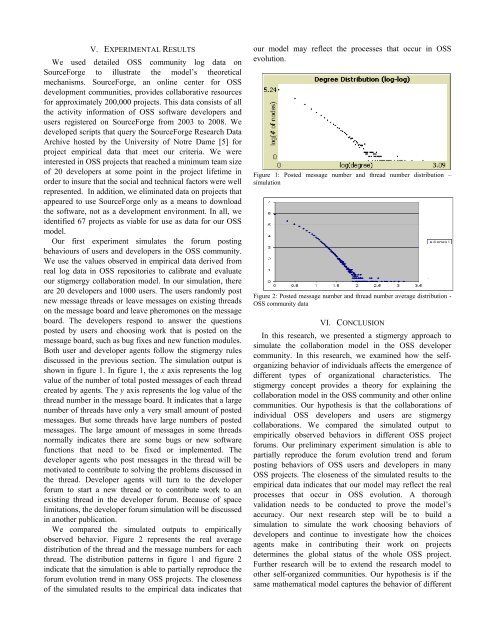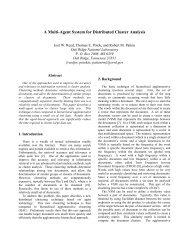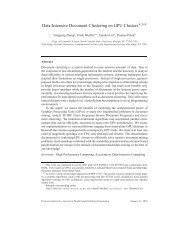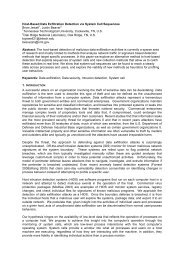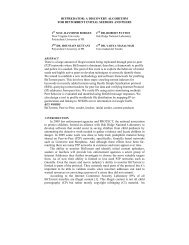A Stigmergy Collaboration Approach in the Open Source Software ...
A Stigmergy Collaboration Approach in the Open Source Software ...
A Stigmergy Collaboration Approach in the Open Source Software ...
- No tags were found...
You also want an ePaper? Increase the reach of your titles
YUMPU automatically turns print PDFs into web optimized ePapers that Google loves.
V. EXPERIMENTAL RESULTSWe used detailed OSS community log data on<strong>Source</strong>Forge to illustrate <strong>the</strong> model’s <strong>the</strong>oreticalmechanisms. <strong>Source</strong>Forge, an onl<strong>in</strong>e center for OSSdevelopment communities, provides collaborative resourcesfor approximately 200,000 projects. This data consists of all<strong>the</strong> activity <strong>in</strong>formation of OSS software developers andusers registered on <strong>Source</strong>Forge from 2003 to 2008. Wedeveloped scripts that query <strong>the</strong> <strong>Source</strong>Forge Research DataArchive hosted by <strong>the</strong> University of Notre Dame [5] forproject empirical data that meet our criteria. We were<strong>in</strong>terested <strong>in</strong> OSS projects that reached a m<strong>in</strong>imum team sizeof 20 developers at some po<strong>in</strong>t <strong>in</strong> <strong>the</strong> project lifetime <strong>in</strong>order to <strong>in</strong>sure that <strong>the</strong> social and technical factors were wellrepresented. In addition, we elim<strong>in</strong>ated data on projects thatappeared to use <strong>Source</strong>Forge only as a means to download<strong>the</strong> software, not as a development environment. In all, weidentified 67 projects as viable for use as data for our OSSmodel.Our first experiment simulates <strong>the</strong> forum post<strong>in</strong>gbehaviours of users and developers <strong>in</strong> <strong>the</strong> OSS community.We use <strong>the</strong> values observed <strong>in</strong> empirical data derived fromreal log data <strong>in</strong> OSS repositories to calibrate and evaluateour stigmergy collaboration model. In our simulation, <strong>the</strong>reare 20 developers and 1000 users. The users randomly postnew message threads or leave messages on exist<strong>in</strong>g threadson <strong>the</strong> message board and leave pheromones on <strong>the</strong> messageboard. The developers respond to answer <strong>the</strong> questionsposted by users and choos<strong>in</strong>g work that is posted on <strong>the</strong>message board, such as bug fixes and new function modules.Both user and developer agents follow <strong>the</strong> stigmergy rulesdiscussed <strong>in</strong> <strong>the</strong> previous section. The simulation output isshown <strong>in</strong> figure 1. In figure 1, <strong>the</strong> x axis represents <strong>the</strong> logvalue of <strong>the</strong> number of total posted messages of each threadcreated by agents. The y axis represents <strong>the</strong> log value of <strong>the</strong>thread number <strong>in</strong> <strong>the</strong> message board. It <strong>in</strong>dicates that a largenumber of threads have only a very small amount of postedmessages. But some threads have large numbers of postedmessages. The large amount of messages <strong>in</strong> some threadsnormally <strong>in</strong>dicates <strong>the</strong>re are some bugs or new softwarefunctions that need to be fixed or implemented. Thedeveloper agents who post messages <strong>in</strong> <strong>the</strong> thread will bemotivated to contribute to solv<strong>in</strong>g <strong>the</strong> problems discussed <strong>in</strong><strong>the</strong> thread. Developer agents will turn to <strong>the</strong> developerforum to start a new thread or to contribute work to anexist<strong>in</strong>g thread <strong>in</strong> <strong>the</strong> developer forum. Because of spacelimitations, <strong>the</strong> developer forum simulation will be discussed<strong>in</strong> ano<strong>the</strong>r publication.We compared <strong>the</strong> simulated outputs to empiricallyobserved behavior. Figure 2 represents <strong>the</strong> real averagedistribution of <strong>the</strong> thread and <strong>the</strong> message numbers for eachthread. The distribution patterns <strong>in</strong> figure 1 and figure 2<strong>in</strong>dicate that <strong>the</strong> simulation is able to partially reproduce <strong>the</strong>forum evolution trend <strong>in</strong> many OSS projects. The closenessof <strong>the</strong> simulated results to <strong>the</strong> empirical data <strong>in</strong>dicates thatour model may reflect <strong>the</strong> processes that occur <strong>in</strong> OSSevolution.Figure 1: Posted message number and thread number distribution –simulationFigure 2: Posted message number and thread number average distribution -OSS community dataVI. CONCLUSIONIn this research, we presented a stigmergy approach tosimulate <strong>the</strong> collaboration model <strong>in</strong> <strong>the</strong> OSS developercommunity. In this research, we exam<strong>in</strong>ed how <strong>the</strong> selforganiz<strong>in</strong>gbehavior of <strong>in</strong>dividuals affects <strong>the</strong> emergence ofdifferent types of organizational characteristics. Thestigmergy concept provides a <strong>the</strong>ory for expla<strong>in</strong><strong>in</strong>g <strong>the</strong>collaboration model <strong>in</strong> <strong>the</strong> OSS community and o<strong>the</strong>r onl<strong>in</strong>ecommunities. Our hypo<strong>the</strong>sis is that <strong>the</strong> collaborations of<strong>in</strong>dividual OSS developers and users are stigmergycollaborations. We compared <strong>the</strong> simulated output toempirically observed behaviors <strong>in</strong> different OSS projectforums. Our prelim<strong>in</strong>ary experiment simulation is able topartially reproduce <strong>the</strong> forum evolution trend and forumpost<strong>in</strong>g behaviors of OSS users and developers <strong>in</strong> manyOSS projects. The closeness of <strong>the</strong> simulated results to <strong>the</strong>empirical data <strong>in</strong>dicates that our model may reflect <strong>the</strong> realprocesses that occur <strong>in</strong> OSS evolution. A thoroughvalidation needs to be conducted to prove <strong>the</strong> model’saccuracy. Our next research step will be to build asimulation to simulate <strong>the</strong> work choos<strong>in</strong>g behaviors ofdevelopers and cont<strong>in</strong>ue to <strong>in</strong>vestigate how <strong>the</strong> choicesagents make <strong>in</strong> contribut<strong>in</strong>g <strong>the</strong>ir work on projectsdeterm<strong>in</strong>es <strong>the</strong> global status of <strong>the</strong> whole OSS project.Fur<strong>the</strong>r research will be to extend <strong>the</strong> research model too<strong>the</strong>r self-organized communities. Our hypo<strong>the</strong>sis is if <strong>the</strong>same ma<strong>the</strong>matical model captures <strong>the</strong> behavior of different


